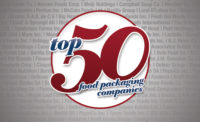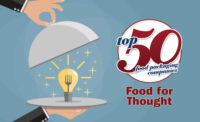Cover Story: Top 50 Food Companies
Top 50 food packaging companies of 2017
Big changes in nutrition facts and consumer eating habits can mean big sales numbers for CPGs.




It is not surprising that in our Top 50 Food Packaging Companies list, Nestlé, Tyson, JBS, PepsiCo and Mars are consistently the top names. One thing is certain, amongst these brands, the ongoing concern over health is a topic that frequently rises to the top of the list. Is an increased healthy portfolio the secret to sales growth?
The 2017 Top 50 Food Packaging Companies Rankings
The modern packaged food landscape
It used to be that fat-free and sugar-free were the big “free-from” trends seen on shelves, but today there are more and more, like soy-free, nut-free, grain-free, gluten-free, preservative-free and dairy-free shouting from food labels. A large number of consumers follow specific diets, some out of medical necessity, but others because of the desire for healthier living, and choosing better-for-you foods. Mintel (mintel.com) research shows that 84% of American free-from consumers buy free-from foods because they are seeking more natural or less processed foods. Forty-three percent of consumers agree that free-from foods are healthier than foods without a free-from claim, while another three in five believe the fewer ingredients a product has, the healthier it is (59%). And while that may not be true, the point is that this is what consumers believe and are searching for in stores.
We know that snacking is on the rise in the U.S. and healthy snacks especially, like meats, dairy and nuts, are climbing sales charts. In addition, granola bars, protein bars and dried fruit sales are climbing as more consumers are eating on the go, but still craving a snack that doesn’t leave behind that guilty feeling. Meat snacks represent a $2.8 billion category. While the potato chip category maintains a dominant lead over other salty snacks in terms of overall sales, household spend on meat snacks is a not-too-distant rival. And competition in the beef jerky space is heating up as more brands launch, promising organic and natural offerings.
The CPG response
Many brands are pushing out new products to satisfy consumers’ cravings for healthier food items. Smaller sizing is a popular choice that allows consumers to still have their favorite snack or candy but in a smaller, portion-controlled size with fewer calories than the full-size treat.
In cooperation with the Partnership for a Healthier America (PHA), major candy companies have announced action to help consumers count calories. Mars Chocolate, Wrigley, Nestlé USA, Ferrero, Lindt, Ghirardelli, Russell Stover and Ferrara Candy Company are striving to offer sizes that contain 200 calories or less per pack – a change expected in the next five years. What’s more, these companies have agreed to print calorie labels on the front of 90% of their products rather than the back where they are right now.
“Chocolate and candy have always been a treat, and this is a big commitment by the participating companies to keep it that way,” says John Downs, president & CEO of the National Confectioners Association.
“We are proud to make this five-year commitment with The Partnership for a Healthier America… This is the first step on our journey to recruit other companies to join us as we work to help consumers manage their sugar intake and ensure that they feel empowered to make informed choices.”
The companies have also established alwaysatreat.com to provide a digital platform to help consumers understand more about the candy they’re eating and how it all fits into a healthy lifestyle.
Another way big CPG brands are trying to reach healthier consumers? By acquiring and investing in better-for-you brands, and making updates to existing brands’ ingredient lists. Also, more brands will be looking at removing certain colors/dyes from foods and ingredients that consumers disapprove of.
In a recent article on SmartBrief.com, General Mills was quoted as saying that their better-for-you brand, Annie’s Homegrown is their largest brand. And it’s no surprise. Annie’s line-up of macaroni and cheese, snacks, crackers, cookies and more delivers organic options to Moms looking to feed their children healthier foods with ingredients list that include recognizable foods.
“General Mills is boosting its marketing investment to increase sales of cereal and yogurt, and has launched a ready-to-eat popcorn line under its Annie’s Homegrown label. ‘Annie’s is our largest brand, and retail sales are increasing nearly 40% so far this year in US Nielsen-measured outlets,’ says COO Jeff Harmening.”
And let’s forget the move for many soup and vegetable brands that are shying away from BPA-lined aluminum cans and using the more popular carton and pouch format for these foods. Millennials, especially, respond to these formats as they see them as healthier, fresher and easier to use.A healthier lifestyle is something many people strive for. Today’s consumer is looking to CPGs to help them satisfy this with better options in meal time, snacks and even in treats. Consumers want it all without sacrificing taste and quality, or a bulging waistline. And it looks like the industry is really listening.
Methodology:
Our top 50 food packagers list uses sources that include annual company reports, news reports, company websites and direct company contacts. Sales are based on calendar year 2016 or the most recent fiscal year that conforms to that timeframe. We used XE, the online currency counter (xe.com), where necessary. We have also used all available resources to separate out food revenue from beverages and other segment revenue. Some companies are marked with an asterisk to indicate an estimate when one of the following occurred: it was impossible to get a breakdown of food vs. other segments; it’s a private company and news sources reported the data, not the company directly or no new information could be found, resulting in us reporting 2015’s revenue.
Looking for a reprint of this article?
From high-res PDFs to custom plaques, order your copy today!









